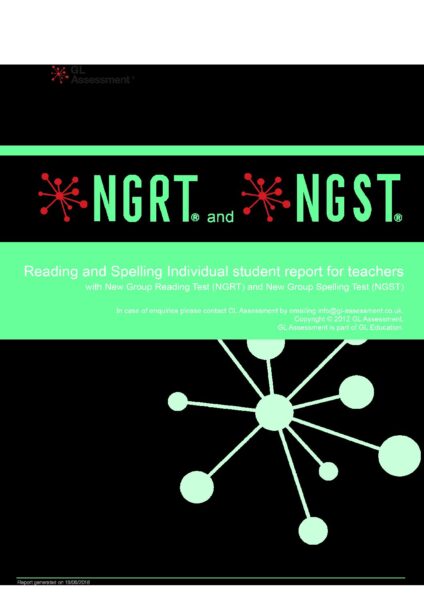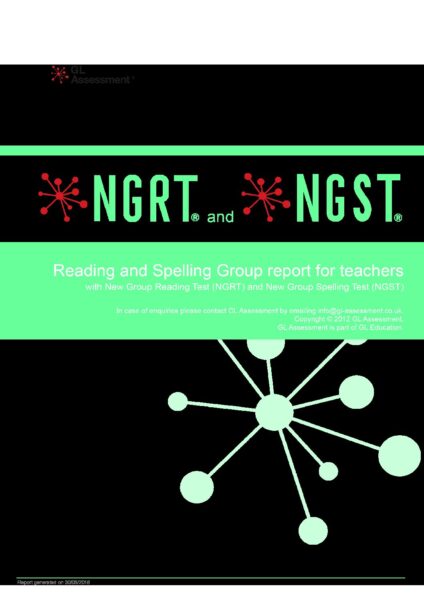
New Group Reading & Spelling Test Bundle [NGRT-NGST-BUNDLE]
Measure reading and spelling skills of students aged 5 – 16 years against the national average
For Ages: 6 – 15 years
Reading Level: Adapts to student’s reading and spelling level
Administration and Scoring: Online through GL Education’s TestWise platform
Length: Varies (adaptive); approximately 20 – 40 minutes
Online Forms, Reports, Kits & e-Manuals
All online resources including Forms, Reports, i-Admins, Kits and e-Manuals.
NGRT & NGST – SINGLE (one administrations of the NGRT & NGST in a year) – min order 10
NGRT & NGST – THRICE (THREE administrations of the NGRT & NGST in a year) – min order 10
NGRT & NGST – TWICE (two administrations of the NGRT & NGST in a year) – min order 10
New Group Reading & Spelling Test Bundle
NGRT
A standardised, adaptive, termly assessment to measure reading skills against the national average. Use it to identify where intervention may be needed, and then to monitor impact and progress made.
Highlights:
- It’s adaptive, responding to a student’s ability as they complete the test so more able readers are challenged and weaker ones remain engaged
- Provides you with a Standard Age Score (SAS), a reading age, Key Stage 2 or GCSE indicators, and progress measures
- Includes practical guidance for next steps
- Standardised on over 11,700 students with its national benchmarks verified each year based on data from half a million students
- Widely used in Education Endowment Foundation (EEF) reading intervention projects
What does NRGT assess?
NGRT is in two parts: sentence completion (which measures decoding with some element of comprehension) and passage comprehension (which measures a range of comprehension skills of increasing difficulty). It therefore tests not just the ability of students to decode what they read, but whether they also comprehend and apply meaning. It can be used to measure phonemic awareness in less able readers too and is particularly useful at transition points.
NGRT tells you the reading ages and the Standard Age Scores of your students, so you can introduce extra challenge or interventions to address problems before they impact on performance. This information will help you in planning curriculum content at the right levels and help to identify those who may have barriers to accessing the curriculum.
To compare ability with current attainment, our Combination Reports combine NGRT data with CAT4 data (as well as the data from Progress Test in Maths and Progress Test in English). Using these you can identify those who are under-achieving or exceeding expectations in English and maths.
The digital version can be used alongside New Group Spelling Test (NGST). The two tests work together, with a Spelling and Reading Report comparing and analysing the results from both.
What do the tests involve?
NGRT is in two parts: sentence completion, which measures decoding with some element of comprehension; and passage comprehension, which measures skills of increasing difficulty.
Children enter the test according to their chronological age and begin with the sentence completion section. Depending on their score, they move on to appropriate phonics-based tasks or to the passage comprehension section. The difficulty increases beyond the student’s ability, challenging their understanding, until their scores show that the difficulty level is too high.
What does NGRT data tell me?
The following digital reports can be instantly generated:
- NGRT group report for teachers – provides an easy to understand overview of reading attainment in a selected group or cohort. Group rank will help you quickly and easily identify those most in need of additional support.
- NGRT individual report for teachers – shows all scores plus an analysis of responses for Sentence Completion and Passage Comprehension and a short narrative report. (Or Sentence Completion and Phonics in the case of students who have taken these parts of the test.)
- NGRT progress report – When completed termly, this provides a summary of the progress made over time. Reports are available as downloadable Excel reports and pdf for easy analysis. Paper reports are also available from the NGRT Scoring & Reporting Service.
What can I do if NGRT flags concerns?
If the student scores less than 85 on NGRT, use York Assessment of Reading for Comprehension (YARC) to further diagnose reading difficulties including reading accuracy, comprehension and rate.
If there is a significant difference between sentence completion and passage comprehension in NGRT, screen for dyslexic tendencies using Rapid (ages 4-15), CoPS (ages 4-7) or LASS (ages 8-15).
How can I use the NGRT with the New Group Spelling Test (NGST)?
You can choose to compare spelling and reading together in under an hour when you use the NGST alongside the digital NGRT.
Spelling and reading reports for both groups and individuals will combine and compare scores from both tests, including SAS, stanine and age equivalent scores.
NGST
A fully adaptive, standardised, termly spelling assessment. New Group Spelling Test (NGST) is an adaptive assessment which allows termly monitoring of spelling skills, benchmarked against the national average. When combined with our New Group Reading Test (NGRT) you can assess reading and spelling together in under an hour.
Questions are delivered via audio and the assessment is adaptive – meaning that questions change based on students’ responses, so more able students can be challenged while weaker students are kept engaged. The reports provide the Standard Age Score (SAS), allowing you to compare each students’ performance with other children of the same age, and track progress. Reports also provide customised implications for teaching and learning as well as offer practical help with next steps in the classroom.
When should I use NGST?
NGST features three equivalent forms A, B and C, so it can be used in each term of the year.
By administering NGST for all students at the beginning, middle and end of a school year, you can stay on top of spelling progress and meet the Ofsted requirement to show strong progress, and gain an informed picture on Progress 8.
Alternatively, you can choose to administer NGST as a screener for all students at the beginning of a year to identify any students who may need additional diagnostic assessment or support for specific literacy difficulties. You can then check the progress of this group midway through the year, then return to check the progress of everyone again at the end of the year.
What do the tests involve?
NGST has two sections:
- Single word section – tests five or six spelling rules in line with the new curricula.
- Spelling in context section – tests a variety of different spelling rules using sentence completion tasks.
What does NGST data tell me?
NGST reports include:
- Group report for teachers – a summary of the age-standardised scores for the chosen group of students, presented in rank order and compared to the national population (national percentile rank).
- Individual report for teachers – offers a detailed analysis of responses to the two sections of NGST, a profile summary and tailored implications for teaching and learning.
- Group progress report for teachers – provides a summary of the progress made over time for the chosen group of students with two points of progress. A group progress report for three points of progress is coming soon.
Reports are available as downloadable Excel reports for easy analysis.
NGST Excel Group and Individual Reports
- A CSV/ Excel report which gives all raw/core data enabling further analysis of results and import into other systems
- A breakdown of scores for all students, including raw score, SAS, NPR and stanine scores as well as individual question scores where applicable.
The Reading and Spelling Group Report for Teachers shows the scores of NGST and NGRT together and gives a summary of the age-standardised scores for the chosen group of students, presented both in rank order and compared to the national population (national percentile rank). Report includes:
Scores for all students in the group, showing SAS for both tests and group ranking
- Analysis of group scores compared to the national average, plus a spelling age and reading age for each student
- Analysis of group scores by previously defined categories such as EAL and SEND
- An overall attainment score detailing whether a student has a higher spelling or reading attainment
The Reading and Spelling Individual Report for Teachers shows all scores, a profile summary for each student and implications for teaching and learning. This report will inform teachers about each individual student’s results in both assessments and indicate how specific issues can be improved. Report includes:
- A breakdown of scores for each student, including the SAS for both tests with confidence bands, National Percentile Rank, stanine, reading age and spelling age
- An overall attainment score detailing whether a student has a higher spelling or reading attainment
- A profile description for each student with written implications for teaching and learning
Reading and Spelling Excel Report
- CSV/Excel report gives all raw/core data for both assessments enabling further analysis of results and import into other systems
- A breakdown of scores for all students, including raw scores, SAS, NPR, spelling and reading ages and stanine scores.





